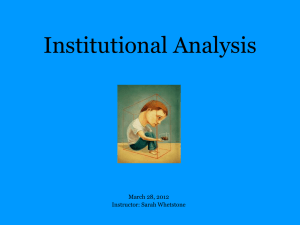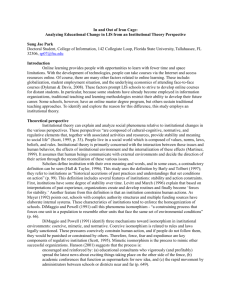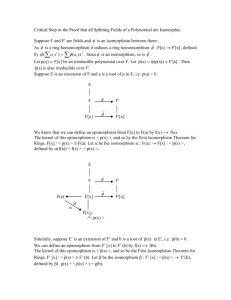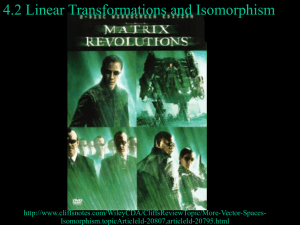*** 1 - WordPress.com
advertisement
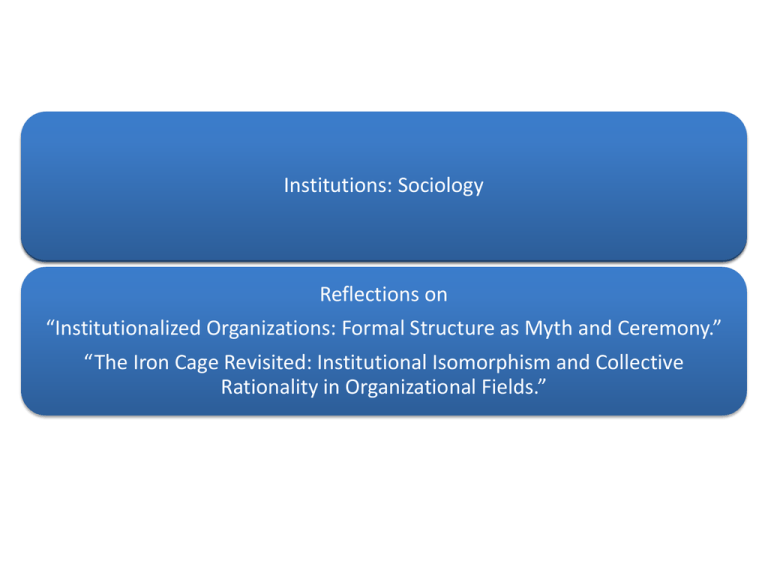
Institutions: Sociology Reflections on “Institutionalized Organizations: Formal Structure as Myth and Ceremony.” “The Iron Cage Revisited: Institutional Isomorphism and Collective Rationality in Organizational Fields.” Content Introduction “Institutionalized Organizations: Formal Structure as Myth and Ceremony.” “The Iron Cage Revisited: Institutional Isomorphism and Collective Rationality in Organizational Fields.” Conclusion Discussion Introduction Neoinstitutionalism describes social theory that focuses on developing a sociological view of institutions: the way they interact and the way they affect society. Outside of the traditional views of economics Why do so many businesses end up having the same organizational structure? How do institutions shape the behavior of individual members? “Institutionalized Organizations: Formal Structure as Myth and Ceremony.” Organizations incorporate societally-rationalized procedures to achieve legitimacy *independent of the practices’ actually efficacy. Institutionalized products, services, techniques, policies, and programs function as myths…organizations adopt them ceremonially “Institutionalized Organizations: Formal Structure as Myth and Ceremony.” Rise of formal organization is attributed to: • Rational organization is seen as an efficient way to structure work • Bureaucratic control is perceived to be useful for dealing with political processes + standardization The authors make a strong distinction between the structure of institutions or practices vs. actual day-to-day activity. “Institutionalized Organizations: Formal Structure as Myth and Ceremony.” Norms of rationality exist in institutional structure a part of social reality and are deeply ingrained in life • “Myths” of institutions take on rationalized, impersonal properties. • They are institutionalized, beyond individuals have legitimacy apart from the outcomes of their implementations. Myths of legitimate organization are already codified, and are drawn upon to create new activities. “Institutionalized Organizations: Formal Structure as Myth and Ceremony.” Proposition 1: Formal organizations emerge in domains *defined by institutional myths… Proposition 2: Modern society tends to have more institutionalized domains and more rationalized institutional structures. • Formal organizations are more likely to emerge in modern societies • Formal organizations in modern societies are more likely to have rational structures. “Institutionalized Organizations: Formal Structure as Myth and Ceremony.” Bureaucracy forms because relational networks become *complex with the beginning of modernity. Institutional myths work as rules depicting formal, rational structure for attaining ends in such a system. Eventually, organizations become a part of the institutional environment… “Institutionalized Organizations: Formal Structure as Myth and Ceremony.” Where did these rational institutional myths come from? 1) Elaboration of complex relational networks. 2) Degree of collective organization. 3) Leadership efforts of local organizations. “Institutionalized Organizations: Formal Structure as Myth and Ceremony.” Isomorphism has crucial consequences… • Organizations incorporate elements which are legitimate, not necessarily efficient. • They employ ceremonial evaluation criteria. • Dependence on externally fixed and legitimate institutions reduces uncertainty and maintains stability. Institutional structure demonstrates an organization’s adherence to valued purposes and means. “Institutionalized Organizations: Formal Structure as Myth and Ceremony.” Long-term organizational *survival increases as state structures elaborate and as organizations respond to institutional rules Arranging organizations along a continuum of technology and strength of output control… • Success: rests on the management of relational networks V.S. depending on isomorphism with institutional rules. “Institutionalized Organizations: Formal Structure as Myth and Ceremony.” “Categorial rules conflict with the logic of efficiency” Institutional rules tend to be highly generalized, they may be inappropriate for some situations Institutional elements can be inconsistent What are the resolutions? “Institutionalized Organizations: Formal Structure as Myth and Ceremony.” Decoupling: the separation of structure from activity e.g. encouraging professionalism, making goals ambiguous The logic of confidence: internal and external participants are acting in good faith “The Iron Cage Revisited: Institutional Isomorphism and Collective Rationality in Organizational Fields.” “The Iron Cage” was a term initially used by Weber to describe bureaucratic control of life in a capitalist society. Weber argued that bureaucratization is caused by: • Competition among firms • Competition among states • Increasing need to control staff and citizens • Middle-class demands for equal protection under the law “The Iron Cage Revisited: Institutional Isomorphism and Collective Rationality in Organizational Fields.” DiMaggio and Powel argue that bureaucratization is caused by: • Processes that make organizations more similar • “Structuration of organizational fields” New organizational fields start out fairly diverse there is a push toward homogeneity e.g. textbooks / legal education legitimacy becomes more important than efficiency to organizations “The Iron Cage Revisited: Institutional Isomorphism and Collective Rationality in Organizational Fields.” Initially, organizations are only responsive to some kind of need then start responding to other organizations and the environment Eventually, larger organizations can dominate & control their environment! “The Iron Cage Revisited: Institutional Isomorphism and Collective Rationality in Organizational Fields.” The term that describes this homogenization: “isomorphism” The environment makes organizations isomorphic Two types of isomorphism: Competitive and Institutional Organizations compete for: resources and customers + legitimacy, political power, and social fitness “The Iron Cage Revisited: Institutional Isomorphism and Collective Rationality in Organizational Fields.” Coercive isomorphism Driven by two forces: 1. Pressures from other organizations on which a focal organization is dependent 2. Pressure to conform to cultural expectations of the society “The Iron Cage Revisited: Institutional Isomorphism and Collective Rationality in Organizational Fields.” Mimetic isomorphism: a response to uncertainty to mimic a peer that they perceive to be successful Best response is to mimic a peer that they perceive to be successful “The Iron Cage Revisited: Institutional Isomorphism and Collective Rationality in Organizational Fields.” Normative isomorphism as a result of professionalization 1. members of professions receive similar training socializes them into similar worldviews 2. members of professions interact through professional and trade associations diffuses ideas among them *The three mechanisms through which institutional ismorphism is diffused are not necessarily empirically distinguishable. Conclusion Institutional isomorphism approach: explain why orgs take on a certain standard form + emphasizes that such a form is not necessarily congruent with organizational practices Note that there are Many levels within organizations and organizational networks… Well-established organizations define what the “proper” form is and are... Many organizational features cannot be explained only by efficiency concerns The articles have explained the character and diversity of these institutional processes Discussion 1: DiMaggio and Powell (1983) What is the significance of DiMaggio and Powell’s theoretical ideas? How do you think their questions and ideas relate to sociology/economic sociology? Discussion 1: DiMaggio and Powell (1983) Lay out the principles underlying observed social phenomena. Provide different lenses through which to understand observed social phenomena. When focus is on how to manage business, we zoom in on one corporation (focal organization) and view social change from its perspective: (e.g.) stakeholder analysis & stakeholder engagement. Discussion 1: DiMaggio and Powell (1983) Shifting Gears: From Focal Org. to Org. Field Firm Stakeholder Stakeholder Firm Focal Organization Stakeholder •Industry •Society •Fortune 500 Firms Stakeholder Firm Discussion 1: DiMaggio and Powell (1983) When we zoom out from the focal organization, we can see the social structure in which it is located & broader social changes that affect the structure. Org. actions are not determined solely by the logic of economic and technological environment but also by the logic of institutional environment. Discussion 2: Meyer and Rowan (1977) How do organizations/institutional practices change? What are the forces that drive organizations to change? (E.g. Consider the case of China) Organizations may be affected by internal members and external environment (vice versa?) How about the Organizational Culture theory (which is founded on the premise that over time, organizations will incorporate human-like personalities, attitudes and values that give them an independent presence)? Consider the complexity of forces that drive organizations to change (state, market, activist groups, shareholders, employers, employees, suppliers, customers…). Discussion 3: DiMaggio and Powell (1983) To what degree can consultants and individuals who work in correlated firms (such as Coke and Pepsi staff) actually spread information? There are moral, legal, and practical obstacles. What are some actual examples of how homogenizing information spreads (aside from public company reports)? Discussion 4: DiMaggio and Powell (1983) Could there be any exceptions to DiMaggio and Powell’s (1983) theory? For instance, Google, and other organizations appear to uphold a distinctive structure and collection of business processes. Search engines have been present for more than a decade and design companies have been around for a century. How do these organizations continue to exist in these ways?
